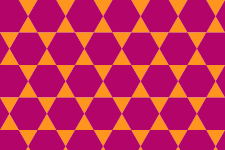Introduction
In mathematics, the tiling of a plane is a collection of tiles that cover the plane without gaps or overlaps. There are different types of tilings. You may use regular or irregular polygons to tile a plane by using a repeating pattern.


These repeating patterns are called periodic tiling.
A Penrose tiling is a pattern of tiles, discovered by Roger Penrose and Robert Ammann, which can completely cover a plane, but only in a pattern that is non-repeating. This type of tiling is called aperiodic tiling.
Kites and Darts
The two main tiles of Penrose tiling are the red Kite and the blue Dart. Explore these shapes below – you can measure the side lengths and internal angles using the ruler and protractor tools:
All the shorter sides are 1 cm long, while the longer sides have a measure of approximately 1.6 - 1.7. This number is called Phi. It is an irrational number with the value of:
= 1.6180339887 ...
This number is referred to as the Golden Ratios and might help us understand the beauty of the designs created by the Dart and the Kite. Let's create our own designs of aperiodic tiling. The tiles are put together with one rule:
No two tiles can be touching so as to form a single parallelogram.
Given this rule, there are many ways to tile an infinite plane with no gaps, overlaps, or holes, but the tiling is always guaranteed to be aperiodic. It also will not have translational symmetry, which means the pattern cannot be shifted to match itself over the entire plane.
Cover the entire Polypad canvas as much as possible using these tiles. Does your initial pattern continuously repeat itself?
Now try answering these questions:
- How can you prove that they tile the plane?
- What are the other patterns do you realize?
Here are some examples:
Further Reasing
- Search for "quasicrystals" to learn about where Penrose tilings occur in nature
- "What is Penrose Tiles?" by Donald Robertson
- "The Trouble with Five" by Craig Kaplan